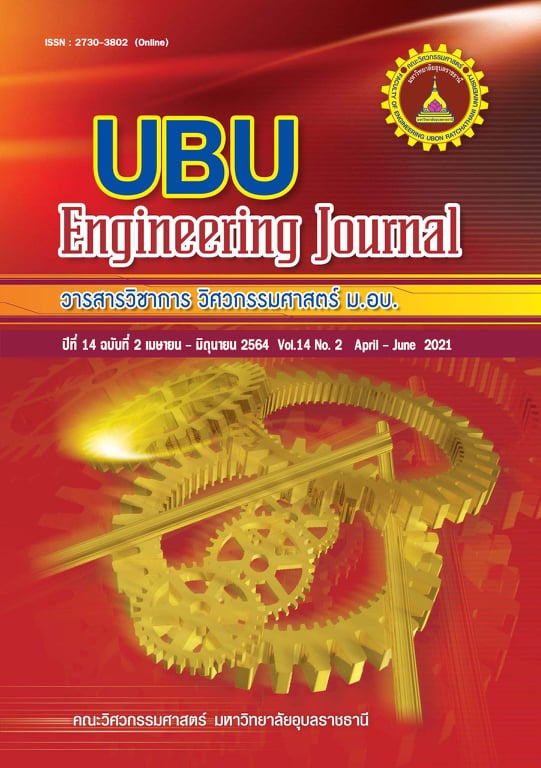Experimental study and investment value analysis of using heat pipe in cooling solar cell panel
Main Article Content
Abstract
This research aimed to experimentally study and to analyze value for investment of using heat pipe in cooling solar cell panel. Three mono-crystalline Silicon solar cell panels with the capacity of 280 W for each panel were used for this test. The first panel (TS1) was tested without installing any heat pipe. The second panel (TS2) was tested with installing a heat pipe set which contained R-11 working fluid. The last panel (TS3) was tested with installing a heat pipe set which contained R-134a working fluid. The result from test showed that the temperatures of all solar cell panels had the same trend. They varied with the solar radiation. The solar cell panel temperatures were increased when the solar radiation increased. The TS3 panel which a heat pipe set with R-134a working fluid was installed performed with the lowest average panel temperature and maximum average efficiency. For the result of value for investment analysis, it was found that using heat pipe in cooling solar cell panel was not worth its cost in this test. The IRRs of the panels with installing heat pipe which contained R-11 and R-134 working fluids were lower than the panel without installing any heat pipe for 3.2 and 3.4% respectively. However, the cost of installing and equipment of heat pipe were determined for the number of installing heat pipe set for a solar panel and equipment retail price. When those costs were reduced, the IRR would increase.
Article Details
References
[2] ประภาพิทย์ บุญหล้า, เจริญพร เลิศสถิตธนกร และ นุชิดา สุวแพทย์. การปรับปรุงประสิทธิภาพของแผงเซลล์แสงอาทิตย์โดยเทคนิคการลดอุณหภูมิ. วารสารวิศวกรรมศาสตร์ มหาวิทยาลัยศรีนครินทรวิโรฒ. 2556; 8(2):1-10
[3] อนุรัตน์ เทวตา และ ยุธนา ศรีอุดม. การศึกษาเชิงทดลองการเพิ่มประสิทธิภาพแผงเซลล์แสงอาทิตย์โดยใช้ท่อความร้อนแบบแบน วารสารวิชาการและวิจัย มทร. พระนคร. 2561; 12(2): 83 – 94.
[4] พงษ์ศักดิ์ พูลศรี. การศึกษาสมรรถนะของระบบผลิตไฟฟ้าและน้ำร้อนพลังงานแสงอาทิตย์. วิทยานิพนธ์ปริญญามหาบัณฑิต คณะวิศวกรรมศาสตร์. มหาวิทยาลัยเทคโนโลยีราชมงคลธัญบุรี. 2557.
[5] Gang, P. Huide, F. Tao, Z. and Jie, J. A numerical and experimental study on a heat pipe PV/T system, Solar Energy, 2011; 85: 911-921.
[6] Tonui JK, Tripanagnostopoulos Y. Improved PV/T solar collectors with heat extraction by forced or natural air circulation, Renewable Energy, 2007:32: 623-637.
[7] ถนัด เกษประดิษฐ. การออกแบบสำหรับการป้องกันการกัดกร่อนของท่อในเครื่องแลกเปลี่ยนความร้อนแบบเทอร์โมไซฟอน. วิทยานิพนธ์ปริญญามหาบัณฑิต คณะวิศวกรรมศาสตร์ มหาวิทยาลัยเชียงใหม่. 2545.
[8] Sriudom Y, Rittidech S, Chompookham T. The Helical Oscillating Heat Pipe: Flow Pattern Behavior Study, Advances in Mechanical Engineering, 2015; 7: 1-11.
[9] ชูชีพ พิพัฒน์ศิถี. เศรษฐศาสตร์การวิเคราะห์โครงการ. พิมพ์ครั้งที่ 4, สำนักพิมพ์ภาควิชาเศรษฐศาสตร์ คณะเศรษฐศาสตร์ มหาวิทยาลัยเกษตรศาสตร์ กรุงเทพฯ. 2544.
[11] สัมพันธ์ ฤทธิเดช. เทคโนโลยีท่อความร้อน. พิมพ์ครั้งที่ 2, สำนักพิมพ์มหาวิทยาลัยมหาสารคาม, มหาสารคาม. 2553.
[12] สุรเชรษฐ์ สีชำนาญ, ธีรพัฒน์ ชมพูคำ และสัมพันธ์ ฤทธิเดช. 2559. การเพิ่มประสิทธิภาพแผงเซลล์แสงอาทิตย์โดยใช้ท่อความร้อนที่ติดตั้งวัสดุพรุนแบบตาข่ายทองแดง. วารสารวิชาการ วิศวกรรมศาสตร์ ม.อบ. 9: 11-22.
[13] Hussam J, Richard M. An investigation into the use of water as a working fluid in wraparound loop heat pipe heat exchanger for applications in

